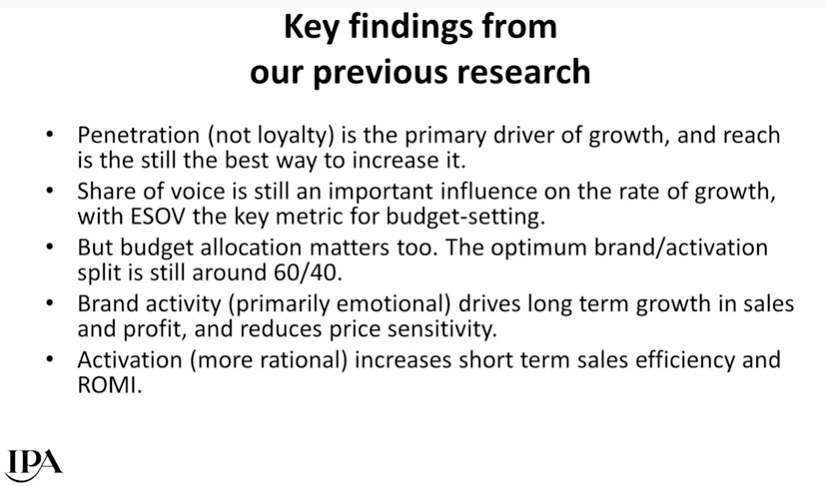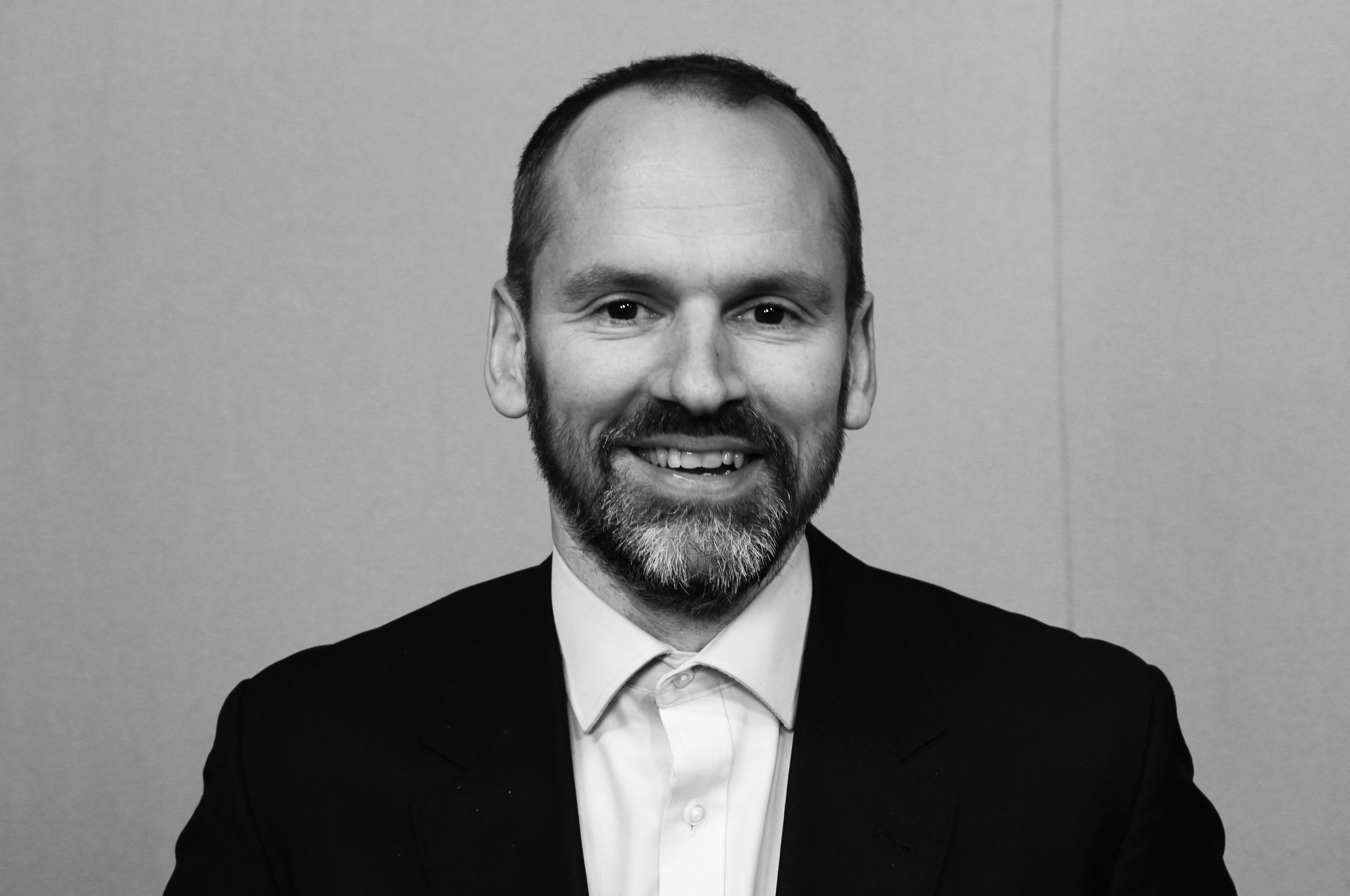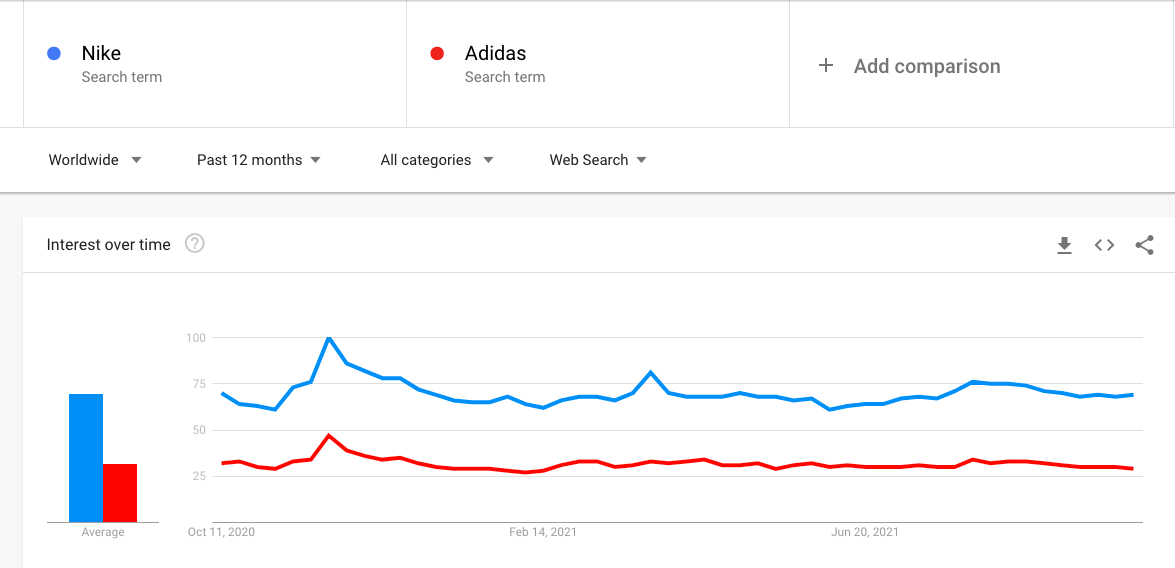Everything you need to know about advertising on one slide ANNOTATED

Readers have asked me to unpack this slide which comes from Les Binet and Peter Field form Adam and Eve DDB.
It summarizes at least ten years of research. It contains some useful nuggets that explain a hell of a lot in the media landscape.
Much of it will be familiar to anyone who has also read How Brands Grow by Byron Sharpe. That’s summarized elsewhere on this site.
So what’s the top line?
- Whatever anyone says, advertising is not half as clever as it pretends to be.
- If you take out many ads, you will sell more stuff.
- Google is Classified Ads on steroids. Don’t expect too much of it.
- Everything and nothing has changed in 40 years.
Let’s go through the slide now and unpack what it means.

1. The engine of growth is penetration not loyalty. And reach is still the best way to increase sales.
What does this actually mean?
If you want to grow your brand you should forget about loyalty. Loyalty marketing under-performs.
Coca-cola count a loyal customer as someone who buys two cans a year. And still they struggle to identify loyal customers.
You might think that you are loyal to Apple but you are not. Not in any meaningful way that will affect sales this year.
Do not spend too much time on loyalty programmes. Your favourite customers can’t recall the name of your product. They call it a “thingumy.”
Penetration describes how much a product is being used by customers. We compare this to the total estimated market for that product or service. The result is that brand’s “reach”.
If you want to sell more stuff, you need to talk to everyone in a category. That sounds obvious. But for years, advertisers have been singing a different tune.
Instead they suggested we use clever tricks to speak to segments of people. Digital platforms such as Facebook tried to convince brands they could target customers. The problem in the first instance is that they couldn’t.
MIT professor Catherine Tucker found targeting gender was unsuccessful. Digital ads couldn’t do it more than half the time. That means they were worse than random.
A Nielsen analysis found only 25% of its ads were reaching the right households. Location-targeted ads wasted as much as 65% of ad spend.
Facebook’s targeting algorithm’s “accuracy” was between 9% and 41% a lawsuit has alleged. It has quoted internal Facebook emails describing the company’s targeting as “abysmal.” But apart from the fact that digital platforms are no good it, to target too-specific consumer groups is a bad idea anyway.
In fact, advertising is something of a blunt tool. It is important to talk to buyers in a category more than your competitors do.
2. Share of voice is still important for growth. ESOV is the key metric for budget-setting.
As I said, advertising is all is about talking to everyone in the category. So it is important that you talk to them more than your competitors do.
And the way to do that is with lots of money. If you want reach in your market you have to pay for it. And if you are under-investing, you can expect your market share to decline.
The relationship between how much you talk to users and how much of the market you own has remained the same. For more than 40 years!
What everyone wants is an excess share of voice (ESOV). That’s share of voice (SOV) minus share of the market (SOM). If you’ve got it, good for you. If you haven’t, you could get into trouble.
3. The best brand allocation is 60:40
Where you put all that money matters too, says the research.
You should put 60% on brand ads and 40% on “activation.” That usually means digital ads you might find on Facebook, Google or Twitter.
Let’s take a look at a terrific case study I often enjoy wheeling out.
A few years ago Adidas announced they would no longer be running TV ads. Instead, they would pour all their cash into activation – ie digital advertising.
But when Google ads went down in South America, Adidas noticed that it did not affect their sales. Oops!
“We had an understanding it was digital advertising driving e-commerce sales. We were over-investing,” said Simon Peel, from Adidas
That’s the nice way to put it. Let’s look at the numbers.
Adidas put 23% of their ad spend into the brand. They put 77% into performance – otherwise known as digital ads.
Before long they discovered brand ads were driving 65% of sales. Adidas screwed the pooch.
Nike poured millions into their ads too. They booked a big TV campaign that backed controversial NFL player Colin Kaepernick. It was all about the brand. Their ad won an Emmy.
The Nike campaign was a huge success. Nike stock rose 5% as a result.
While reading this, take a look in your cupboard. Which trainers do you wear? Nike or Adidas? You can compare the search terms on Google Trends too. Nike slays Adidas.
Most neuroscientists accept the idea that decision-making is emotional in nature. Nike bet the farm on that idea and won.
So what? Well, many of us may be toiling in the digital salt mines creating content like this post. Sometimes we may wonder at the efficacy of this content. Will it drive sales? And the answer, according to the research is yes, 40% of the time.
Successful brands spend 60% of their budget putting feelings into their customers’ heads. Then they spend the rest of it reminding them of it. This is “activation.”
4. Brand activity uses emotional messages. These drive long terms sales, market share and profit. They also reduce price sensitivity.
Translation: goose the brand and you can charge more. And people will remember you longer.
5. Activation with more rational messages increases short-term sales efficiency.
Spend 40% of your budget reminding people you exist online. It will help you drive sales this week.
Here endeth the lesson.
Related stories
Try this sniff test to see if your business stands out
Business intelligence tools give your business a competitive advantage
6 undeniable reasons why Power BI is a good skill to have for any marketer
Everything you need to know about advertising on one annotated slide
About the author

My name is Andy Pemberton. I am an expert in data visualization. I guide global clients such as Lombard Odier, the European Commission and Cisco on the best way to use data visualization and then produce it for them: reports, infographics and motion graphics. If you need your data visualized contact me at andy@furthr.co.uk or call 07963 020 103
Posted in: Uncategorized